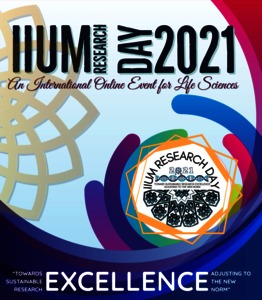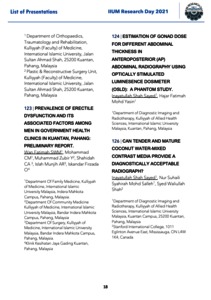Sayed, Inayatullah Shah and Mod Yasin, Hajar Fatimah (2021) Estimation of gonad dose of different abdominal thickness in anteroposterior (AP) abdominal radiography using optically stimulated luminescence dosimeter (OSLD): a phantom study. In: IIUM Research Day 2021: An International Online Event for Life Sciences, 24 Nov 2021, Virtual. (Unpublished)
|
PDF (Abstract)
- Supplemental Material
Restricted to Registered users only Download (91kB) | Request a copy |
||
![[img]](http://irep.iium.edu.my/95292/9.hassmallThumbnailVersion/IRD%202021%20-%20Programme%20Book.png)
|
PDF
- Supplemental Material
Download (525kB) | Preview |
|
![[img]](http://irep.iium.edu.my/95292/10.hassmallThumbnailVersion/IRD%202021%20-%20Abstract%20Book.png)
|
PDF
- Supplemental Material
Download (158kB) | Preview |
|
|
PDF (Slide Presentation)
- Presentation
Restricted to Repository staff only Download (493kB) | Request a copy |
Abstract
Radiation dose to organs in radiography is commonly calculated using phantoms representing a standard adult body but not to the patient which is the common cause of error in measured radiation dose. The gonad is one of the radiosensitive organs in the human body, located in the close proximity of collimated beam when AP abdominal radiography is conducted. Thus, our study measured the gonad dose at different abdominal thickness with and without the lead shield in AP radiographic examination. A whole body anthropomorphic phantom PBU-50 was exposed selecting 75 KVp, 18 mAs exposure factor with Siemens Multix Top X-ray system. Modelling clay of 0 – 3 cm thick layer was used as an additional abdominal thickness of the phantom simulating different anatomical thickness of patients. The radiation dose to the gonad with & without modelling clay and with & without lead shielding was measured using OSLD. Data were analysed in terms of mean dose, standard deviation and percentage difference in the dose between with & without modelling clay and with & without lead shielding. Wilcoxon signed rank tests were used to test the significance in the difference in gonad dose with and without the lead shield. Pearson correlation was performed to study the relationship between the additional abdominal thickness and measured gonad dose. The results show the gonad dose with shield and without modelling clay was 0.15±0.03 mGy, and with 1 cm and 3 cm modelling clay 0.16±0.05 mGy. Without lead shield and modelling clay 0.50±0.09 mGy, with 1 cm and 3 cm modelling clay 0.62±0.07 and 0.66±0.19 mGy gonad dose was measured. No significant difference (p =0.180) in gonad dose with lead shielding at 0 – 3cm additional abdominal thickness was found. A positive correlation (r =1, p <0.00) between the abdominal thickness and gonad dose was observed. In conclusion, the gonad dose increased with the increase in abdominal thickness, shielding of gonad is recommended to minimize the radiation dose despite different patient thickness and size.
| Item Type: | Proceeding Paper (Slide Presentation) |
|---|---|
| Additional Information: | 6128/95292 |
| Uncontrolled Keywords: | Radiation dose, OSLD, gonad dose, radiography |
| Subjects: | Q Science > QC Physics |
| Kulliyyahs/Centres/Divisions/Institutes (Can select more than one option. Press CONTROL button): | Kulliyyah of Allied Health Sciences Kulliyyah of Allied Health Sciences > Department of Diagnostic Imaging and Radiotherapy |
| Depositing User: | Dr Inayatullah Shah Sayed |
| Date Deposited: | 19 Jan 2022 11:17 |
| Last Modified: | 19 Jan 2022 11:17 |
| URI: | http://irep.iium.edu.my/id/eprint/95292 |
Actions (login required)
 |
View Item |



 Download Statistics
Download Statistics Download Statistics
Download Statistics